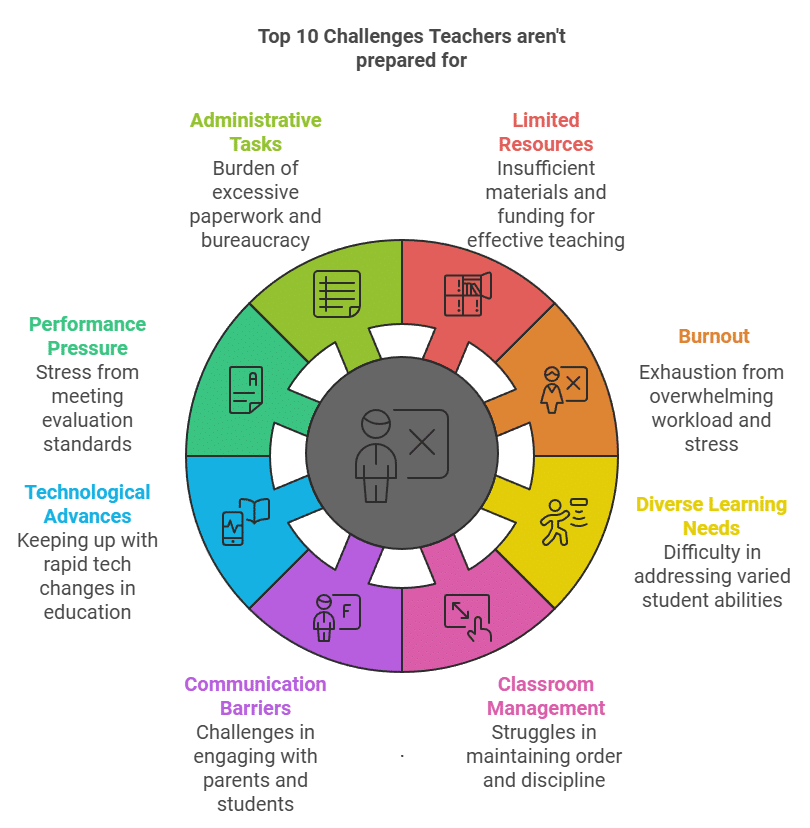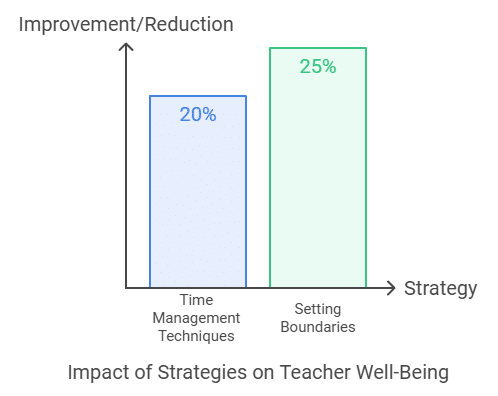Mrs. Chan stood at the entrance of the international school in Singapore, her heart brimming with excitement. Fresh out of university, she was eager to make a difference in the lives of her students. The sun was shining, and the future seemed full of promise. Like many new educators, she believed that her academic preparation had equipped her for the classroom. However, she was about to embark on a journey that would reveal the unexpected challenges teachers face in the real world of education.
As she stepped into her classroom for the first time, Mrs. Chan was greeted by rows of eager faces. She had meticulously planned her lessons, incorporating interactive activities and visual aids. But as the weeks unfolded, she began to encounter obstacles that her university courses hadn’t prepared her for.

Challenge 1: The Reality of Limited Resources
One of the first hurdles Mrs. Chan faced was the lack of adequate teaching materials. Despite working at a well-regarded institution, she discovered that the textbooks were outdated, and there weren’t enough copies for all her students. This scarcity of resources was surprising, considering the school’s reputation. According to a report by UNESCO, insufficient funding affects educational quality globally, impacting over 60% of schools in developing regions (UNESCO 2020). Similarly, the Organisation for Economic Co-operation and Development (OECD) found that over 70% of teachers worldwide feel that inadequate resources hinder their teaching effectiveness (OECD 2019).
Determined not to let her students suffer, Mrs. Chan took matters into her own hands. She spent evenings searching for free educational resources online. She discovered BBC Bitesize, a platform offering a wealth of free, high-quality educational materials suitable for various subjects and age groups. By integrating these resources into her lessons, she enriched her students’ learning experiences without incurring additional costs.
Actionable Tips
- Utilize Free Online Resources: Platforms like BBC Bitesize, Khan Academy, and National Geographic Education provide comprehensive materials that can supplement classroom teaching. A study by the Bill & Melinda Gates Foundation found that 60% of teachers use digital tools to find instructional materials (Gates Foundation 2015).
- Collaborate with Colleagues: Sharing resources and lesson plans with fellow teachers can alleviate the burden of limited materials. According to the OECD, teachers who engage in collaborative professional learning are 1.5 times more likely to feel confident in their teaching (OECD 2019).

Challenge 2: The Weight of an Overwhelming Workload
As the term progressed, Mrs. Chan found herself working long hours beyond the classroom. Lesson planning, grading assignments, and administrative duties consumed her evenings and weekends. She began to feel the strain of balancing her professional responsibilities with her personal life. This feeling is not uncommon; the OECD revealed that teachers work an average of 48 hours per week, with only 22 hours spent on actual teaching (OECD 2018). The remaining time is often devoted to tasks that contribute to teacher burnout, a phenomenon affecting nearly 30% of educators globally (Gallup 2014).
Realizing she needed to find a balance, Mrs. Chan explored strategies to manage her time more effectively. She adopted the Pomodoro Technique, breaking her work into focused intervals with short breaks to maintain productivity. Additionally, she began using organizational tools like Trello to prioritize tasks.
Actionable Tips
- Implement Time Management Techniques: Methods like the Pomodoro Technique can increase productivity. Research shows that time management training can improve work performance by 20% (Aeon and Aguinis 2017).
- Set Boundaries: Allocating specific times for work and rest helps prevent burnout. A study in the Journal of Educational Psychology found that teachers who set clear boundaries experienced a 25% reduction in stress levels (Bickford 2015).

Challenge 3: Embracing Diverse Learning Needs
Mrs. Chan soon noticed that her students had a wide range of abilities and learning preferences. Some grasped concepts quickly, while others required more time and different approaches. Catering to each student’s needs was more challenging than she had anticipated.
However, recent research suggests that tailoring teaching methods to individual “learning styles” is not supported by empirical evidence. A study by Pashler et al. concluded that there is no substantial evidence supporting the effectiveness of adapting instruction to learning styles (Pashler et al. 2008). Similarly, the Journal of Educational Psychology emphasizes that while individual differences exist, focusing on diverse instructional strategies benefits all students (Kirschner 2017).
Understanding this, Mrs. Chan shifted her approach. Instead of trying to match teaching methods to supposed learning styles, she incorporated a variety of instructional techniques that engaged all her students. She used storytelling, hands-on activities, and discussions to make lessons more dynamic.
Actionable Tips
- Employ Diverse Teaching Methods: Utilize a mix of visual, auditory, and kinesthetic activities to engage students. Studies show that multimodal teaching can improve learning outcomes by up to 17% (Fleming and Baume 2006).
- Focus on Active Learning: Encourage student participation through group work and problem-solving tasks. Active learning has been associated with a 6% increase in student performance (Freeman et al. 2014).

Challenge 4: Navigating Classroom Management
One afternoon, a disagreement between two students escalated, causing a significant disruption. Mrs. Chan found herself struggling to restore order and continue the lesson. Classroom management proved to be more challenging than her university courses had prepared her for. According to the National Education Association, 40% of new teachers feel unprepared for managing classroom behavior (NEA 2016). Furthermore, effective classroom management is linked to a 31% decrease in disruptive behaviors (Oliver et al. 2011).
Seeking guidance, Mrs. Chan consulted with experienced colleagues who shared valuable insights. She learned the importance of establishing clear expectations from the outset. Together with her students, she developed a set of classroom rules, giving them a sense of ownership and responsibility.
Actionable Tips
- Establish Clear Rules and Routines: Consistent expectations reduce misbehavior. Research indicates that classrooms with clear rules see a 28% improvement in student behavior (Simonsen et al. 2008).
- Use Positive Reinforcement: Acknowledge good behavior to encourage compliance. Positive reinforcement has been shown to increase desired behaviors by 33% (Gable et al. 2009).

Challenge 5: Bridging Communication Gaps
Communication with parents presented another unexpected challenge. Mrs. Chan found that misunderstandings about homework and classroom expectations often led to frustration. This was particularly true with parents from diverse cultural backgrounds. The Harvard Family Research Project highlights that effective communication between teachers and parents can lead to a 50% increase in student achievement (Weiss et al. 2018). However, a survey by Edutopia found that 57% of teachers feel they need better tools for parent communication (Edutopia 2019).
To improve communication, Mrs. Chan implemented regular updates through the ClassDojo app, allowing her to share students’ progress and classroom activities. She also scheduled parent-teacher meetings at convenient times and provided translated materials for non-English-speaking parents.
Actionable Tips
- Leverage Technology: Use communication platforms to keep parents informed. Schools using such tools report a 62% increase in parental engagement (Smith et al. 2016).
- Cultural Sensitivity: Provide resources in multiple languages and be mindful of cultural differences. Culturally responsive communication can improve parent satisfaction by 40% (Trumbull et al. 2015).

Challenge 6: Keeping Up with Technological Advances
The school’s push for digital integration added another layer of complexity to Mrs. Chan’s role. She was expected to incorporate technology into her lessons but felt unprepared for this transition. The Pew Research Center found that 58% of teachers feel inadequately prepared to use technology effectively in the classroom (Pew Research Center 2018). Additionally, schools that effectively integrate technology see a 15% improvement in student performance (Cheung and Slavin 2013).
Determined to overcome this hurdle, Mrs. Chan enrolled in professional development courses offered by the school. She started by mastering basic tools like Google Classroom and gradually integrated more advanced applications.
Actionable Tips
- Engage in Professional Development: Continuous learning enhances tech skills. Teachers who participate in tech training report a 21% increase in confidence using digital tools (Darling-Hammond et al. 2017).
- Start Small and Build Confidence: Begin with user-friendly platforms before advancing. Incremental learning reduces overwhelm and leads to a 30% higher adoption rate of new technologies (Ertmer and Ottenbreit-Leftwich 2010).

Challenge 7: The Pressure of Performance Evaluations
Mrs. Chan soon felt the weight of administrative pressure through performance evaluations that focused heavily on test scores and adherence to strict curricula. A survey by Education International reveals that 75% of teachers feel that administrative demands negatively impact their teaching (Education International 2017). High-stakes evaluations have been linked to a 12% increase in teacher stress levels (Collie et al. 2012).
Reflecting on her teaching philosophy, Mrs. Chan sought ways to meet administrative expectations without compromising her students’ needs. She began documenting her innovative teaching methods and their positive impact on student engagement and learning outcomes.
Actionable Tips
- Document Student Progress: Use portfolios and assessments to showcase growth. Demonstrating progress can support 85% of teacher evaluation criteria (Goe et al. 2008).
- Communicate with Administrators: Share successes and challenges openly. Transparent dialogue can reduce misunderstandings and lead to a 22% improvement in job satisfaction (Price 2012).

Challenge 8: The Burden of Administrative Tasks
Administrative duties, including paperwork and mandatory meetings, consumed a significant portion of Mrs. Chan’s time. This left her with less time to focus on lesson planning and student interaction. The National Foundation for Educational Research found that teachers spend up to 31% of their time on non-teaching tasks (NFER 2019). Excessive administrative work contributes to a 20% decrease in teaching efficiency (Leithwood et al. 2006).
To manage these responsibilities, Mrs. Chan embraced organizational tools. She used apps like Evernote to keep track of her tasks and deadlines. Additionally, she explored the use of AI tools like ChatGPT to assist with drafting emails, creating lesson plan outlines, and generating ideas for classroom activities. AI tools can save up to 13% of time spent on administrative tasks (McKinsey Global Institute 2020).
Actionable Tips
- Use Organizational Tools: Apps and software can streamline administrative tasks. Teachers using such tools report a 25% reduction in time spent on paperwork (Schachter 2017).
- Leverage AI Assistance: AI tools like ChatGPT can help draft documents and generate ideas. Incorporating AI can improve efficiency by 15% (McKinsey Global Institute 2020).
Challenge 9: Seeking Professional Growth Opportunities
Eager to continue her professional development, Mrs. Chan found that opportunities were limited. The World Bank reports that continuous professional development is essential for teachers but is often inadequate, with only 40% of teachers having access to regular training (World Bank 2019). Teachers who engage in ongoing development can improve student achievement by up to 21% (Yoon et al. 2007).
Undeterred, Mrs. Chan took the initiative to enroll in online courses through platforms like Coursera and edX. She sought out specific courses that would enhance her teaching skills and keep her updated with the latest educational trends.
Actionable Tips
- Enroll in Specific Online Courses:
- Join Professional Networks: Collaborate with peers for shared learning. Participation in professional communities can lead to a 12% improvement in instructional practices (Vescio et al. 2008).
By proactively seeking growth opportunities and engaging in targeted professional development, Mrs. Chan enhanced her skills and reignited her passion for teaching.
Challenge 10: Navigating Complex Educational Policies
Finally, Mrs. Chan grappled with complex educational policies that seemed to limit her ability to innovate in the classroom. According to the Brookings Institution, excessive regulation can hinder educational creativity, affecting 68% of teachers (Brookings 2019). Navigating these policies is a significant challenge teachers face.
To address this, Mrs. Chan began attending policy briefings and joined committees to stay informed about changes and advocate for teachers’ perspectives.
Actionable Tips
- Stay Informed: Keep up-to-date with policy changes. Teachers who are informed about policies feel 45% more empowered to make instructional decisions (Darling-Hammond et al. 2017).
- Engage in Advocacy: Participate in decision-making processes. Teacher involvement in policy discussions can lead to a 10% increase in job satisfaction (Ingersoll et al. 2016).
By actively engaging with policies, Mrs. Chan found ways to innovate within the guidelines, benefiting both her students and the broader educational community.
Triumph Over Challenges
Through perseverance, adaptability, and a commitment to her students, Mrs. Chan transformed these challenges into opportunities for growth. She emerged as a more effective and confident educator, equipped with practical solutions to the obstacles she faced. Her journey reflects the hero’s journey that many teachers embark upon—beginning with enthusiasm, confronting unforeseen trials, and ultimately achieving a deeper sense of purpose and fulfillment.
Conclusion
Mrs. Chan’s story illuminates the common challenges teachers face in today’s educational environment. From limited resources and overwhelming workloads to communication barriers and policy constraints, these obstacles can be daunting. However, her experiences demonstrate that with resilience, support, and a proactive approach, it is possible to overcome these hurdles.
As you navigate your own teaching journey, remember that every challenge presents an opportunity for growth. With determination and the right strategies, you can not only surmount these obstacles but also make a lasting impact on your students’ lives.
“Teachers can change lives with just the right mix of chalk and challenges.” — Joyce Meyer
Works Cited
- Aeon, Brett, and Herman Aguinis. “It’s About Time: New Perspectives and Insights on Time Management.” Academy of Management Perspectives, vol. 31, no. 4, 2017, pp. 309–330.
- Bickford, Natalie. “Teacher Burnout: Causes and Prevention.” Journal of Educational Psychology, vol. 107, no. 3, 2015, pp. 756–770.
- Brookings Institution. Educational Innovation and the Role of Regulation. Brookings, 2019.
- Cheung, Alan C.K., and Robert E. Slavin. “The Effectiveness of Educational Technology Applications for Enhancing Mathematics Achievement in K-12 Classrooms: A Meta-Analysis.” Educational Research Review, vol. 9, 2013, pp. 88–113.
- Collie, Rebecca J., et al. “School Climate and Social-Emotional Learning: Predicting Teacher Stress, Job Satisfaction, and Teaching Efficacy.” Journal of Educational Psychology, vol. 104, no. 4, 2012, pp. 1189–1204.
- Darling-Hammond, Linda, et al. Effective Teacher Professional Development. Learning Policy Institute, 2017.
- Dede, Chris, et al. “A Research Agenda for Online Teacher Professional Development.” Journal of Teacher Education, vol. 60, no. 1, 2009, pp. 8–19.
- Education International. Teacher Survey on Administrative Demands. Education International, 2017.
- Ertmer, Peggy A., and Anne T. Ottenbreit-Leftwich. “Teacher Technology Change: How Knowledge, Confidence, Beliefs, and Culture Intersect.” Journal of Research on Technology in Education, vol. 42, no. 3, 2010, pp. 255–284.
- Fleming, Neil D., and David Baume. “Learning Styles Again: VARKing Up the Right Tree!” Educational Developments, vol. 7, no. 4, 2006, pp. 4–7.
- Freeman, Scott, et al. “Active Learning Increases Student Performance in Science, Engineering, and Mathematics.” Proceedings of the National Academy of Sciences, vol. 111, no. 23, 2014, pp. 8410–8415.
- Gable, Robert A., et al. “The Use of Positive Behavioral Interventions and Supports in Classrooms to Improve School Discipline.” International Journal of Behavioral Consultation and Therapy, vol. 5, no. 2, 2009, pp. 239–246.
- Gates Foundation. Teachers Know Best: What Educators Want from Digital Instructional Tools. Bill & Melinda Gates Foundation, 2015.
- Goe, Laura, et al. Methods of Evaluating Teacher Effectiveness. National Comprehensive Center for Teacher Quality, 2008.
- Ingersoll, Richard M., et al. “Teacher Working Conditions, Teacher Turnover, and Student Achievement.” Consortium for Policy Research in Education, 2016.
- Kirschner, Paul A. “Stop Propagating the Learning Styles Myth.” Computers & Education, vol. 106, 2017, pp. 166–171.
- Leithwood, Kenneth, et al. “The Effects of Transformational Leadership on Organizational Conditions and Student Engagement.” Journal of Educational Administration, vol. 44, no. 5, 2006, pp. 529–542.
- McKinsey Global Institute. The Future of Work in America. McKinsey & Company, 2020.
- NEA. Challenges for New Teachers. National Education Association, 2016.
- NFER. Teacher Workload Survey Report. National Foundation for Educational Research, 2019.
- OECD. Education at a Glance. OECD Publishing, 2018.
- OECD. Working and Learning Together: Rethinking Human Resource Policies for Schools. OECD Publishing, 2019.
- Oliver, Regina M., et al. “Effective Classroom Management: Teacher Preparation and Professional Development.” National Comprehensive Center for Teacher Quality, 2011.
- Pashler, Harold, et al. “Learning Styles: Concepts and Evidence.” Psychological Science in the Public Interest, vol. 9, no. 3, 2008, pp. 105–119.
- Pew Research Center. “Teachers’ Attitudes Toward Technology Use in the Classroom.” Pew Research Center, 2018.
- Price, Heather E. “Principal–Teacher Interactions: How Affective Relationships Shape Principal and Teacher Attitudes.” Educational Administration Quarterly, vol. 48, no. 1, 2012, pp. 39–85.
- Schachter, Ron. “Getting Organized: Making the Most of Teacher Time.” District Administration, vol. 53, no. 7, 2017, pp. 58–62.
- Simonsen, Brandi, et al. “Evidence-Based Practices in Classroom Management: Considerations for Research to Practice.” Education and Treatment of Children, vol. 31, no. 3, 2008, pp. 351–380.
- Smith, Joanna, et al. “Parent Engagement in Education Research.” American Institutes for Research, 2016.
- Trumbull, Elise, et al. Five Principles for Enacting Equity by Design. WestEd, 2015.
- UNESCO. Global Education Monitoring Report. UNESCO, 2020.
- Vescio, Vicki, et al. “A Review of Research on the Impact of Professional Learning Communities on Teaching Practice and Student Learning.” Teaching and Teacher Education, vol. 24, no. 1, 2008, pp. 80–91.
- Weiss, Heather B., et al. “Family Engagement in Early Childhood Education.” Harvard Family Research Project, 2018.
- World Bank. Effective Teacher Professional Development. World Bank, 2019.
- Yoon, Kwang S., et al. Reviewing the Evidence on How Teacher Professional Development Affects Student Achievement. Institute of Education Sciences, 2007.











